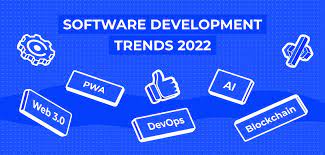Top 5 Software Development Trends in 2023 You Should Know

Last Updated on March 3, 2024 by Ali Hamza
The software development industry is always changing and evolving. In IT software development companies, we need to be aware of the latest trends so that we can be ahead of the curve and stay relevant in our field.
Because what was popular last year may not be popular this year. That’s why it’s important to stay up-to-date on the latest trends so you can be ahead of the curve.
Here in this guide, we will look at the top 5 software development trends predicted for 2023. So without further ado, let’s get started!
Top 5 Software Development Trends in 2023
If you’re in the IT software development company or industry, then you need to be aware of the following 5 trends predicted for 2022. So just check out them:
1. Cloud-Based Development:
Cloud-based development is a big trend that is predicted to continue to grow in popularity in the coming years. Developers are moving away from traditional on-premise development and instead opting for cloud-native solutions that are more flexible and scalable.
Cloud computing is being driven by the need for better collaboration, faster development cycles, and lower costs.
When it comes to cloud-based development, there are many options available such as Amazon Web Services (AWS), Microsoft Azure, and Google Cloud Platform (GCP) that provide developers with the tools and resources they need to build, test, and deploy applications in the cloud.
So if you’re not already using a cloud-based service, you should consider it for your next project.
2. Native app development:
As mobile devices become more and more prevalent, the demand for native app development will continue to grow. Native apps offer a better user experience than web apps because they are designed specifically for the platform they are built for.
As a result, they can use all the features of the device, including the camera, GPS, and push notifications.
3. Cross-platform and hybrid deployment:
With the rise of mobile devices, there is a need for apps that can be deployed across multiple platforms.
This trend is known as a cross-platform or hybrid deployment. Developers are using tools like React Native and Ionic to build apps that can be deployed on both iOS and Android devices.
By doing so, they can reach a wider audience and reduce development costs and time. Also, cross-platform desktop apps are being built using tools like Cordova and Electron.
4. Low-Code development platform:
Another big trend that is predicted for 2022 is low-code and no-code development. This type of development is becoming increasingly popular as it enables businesses to develop applications without having to write a lot of code. Instead, they can use visual drag-and-drop tools to build their applications.
This trend is being driven by the need for faster development times and the need to make application development more accessible to non-technical users.
5. Progressive web apps:
Progressive web apps (PWAs) are a type of web app that uses modern web technologies to provide a user experience that is similar to that of a native app.
PWAs are designed to be fast, reliable, and engaging. They are also able to work offline and can be installed on a user’s device.
For businesses that want to reach users on both mobile and desktop devices, these are effective options. Moreover, the trend of PWAs is also being driven by the need to provide a better user experience and reduce development costs.
What is the next big thing in software development?
The field of software development is constantly evolving, with new technologies and trends emerging every year. While it can be challenging to predict the next big thing, there are several promising developments on the horizon.
One area that is likely to see significant growth is artificial intelligence (AI) and machine learning. With the increasing availability of big data and the growing demand for intelligent applications, AI has the potential to revolutionize software development. From chatbots and virtual assistants to predictive analytics and personalized recommendations, AI-powered software has already begun to reshape our world.
Another trend that is likely to continue is the shift towards cloud computing. As more organizations move their operations to the cloud, developers will need to create applications that can take full advantage of cloud infrastructure. This includes developing applications that are scalable, secure, and easy to deploy and manage.
Finally, the rise of low-code and no-code platforms is poised to transform the software development landscape. These platforms allow users to create applications without needing to know how to code, opening up software development to a wider audience. This trend is likely to accelerate as more organizations seek to streamline their development processes and reduce the time and resources required to create new applications.
Final Verdict
Software development trends are always changing and evolving. To stay ahead of the curve, it’s key to stay up-to-date on the latest trends. In this guide, we have looked at the top 5 software development trends predicted for 2022.
These trends include cloud-based development, native app development, cross-platform and hybrid deployment, low-code development platform, and progressive web apps.
So if you’re looking to stay ahead of the curve, be sure to keep these trends in mind.
We hope you enjoyed this guide. If you have any questions or comments, please feel free to reach out to us. We would be more than happy to help you out. Thank you for reading!


